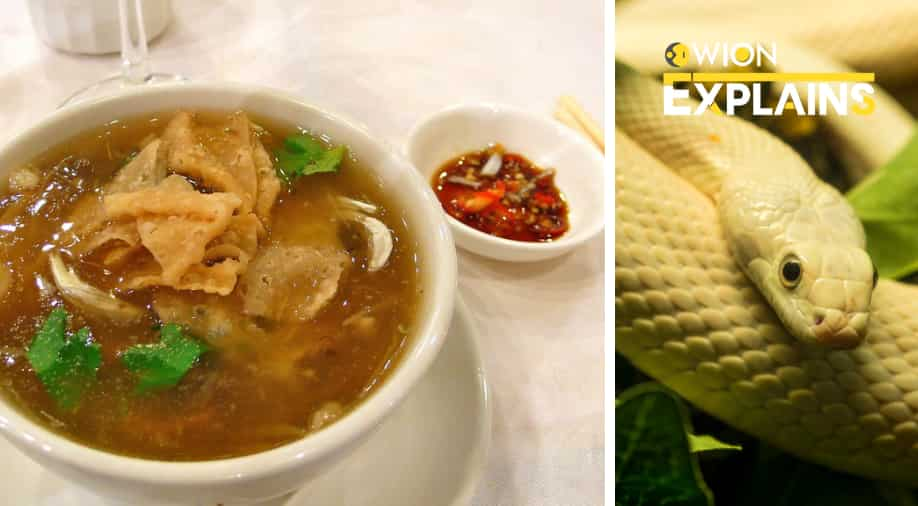Explained | Why China consumes snake soup in winter and why it is disappearing?
Story highlights
Not known to many people, snake soup is loaded with vitamins and proteins and carries health benefits which include improving sleep and preventing cancer
It was only days back that the limited-edition snake-soup pizza, launched by Pizza Hut and Ser Wong Fun – one of the longest-standing snake restaurants in Hong Kong – made a lot of buzz and many wondered whether it was safe to consume and how would it taste?
Not many knew that this snake-soup pizza was inspired by the bowl of snake soup, which is a Cantonese delicacy and is a very popular dish in China, especially in the winter season. The snake soup, when properly prepared, actually doesn't look, smell or taste weird.
History of snake soup
According to the experts, snake soup has been part of the cuisine in south China for thousands of years and the recipe was most widely documented by the late Qing dynasty's one of the last imperial scholars and native of Guangzhou, Jiang Kongyin (1864-1952), who had gained the title of the finest gourmet of Guangdong province.
trending now
Among the famous recipes of Jiang, the most famous is the five-snake soup which is said to have traditional Chinese medicinal benefits of increasing blood circulation and decreasing “dampness” in the body.
The five-snake soup's star ingredients include the five species of snakes, both venomous and non-venomous, however, the recipe of Jiang also included chicken, abalone, fish maw, bamboo shoots, shiitake mushrooms and wood ear (black ear) fungus.
The snake soup's complex and labour-intensive recipe has made it a unique speciality.
Why snake soup is considered healthy?
“Snake has been said to be healthy since the Han dynasty, hence it’s in a lot of important Chinese medicine formulas,” said Gigi Ng, Ser Wong Fun's fourth-generation owner while speaking to the South China Morning Post. The outlet has more than a century of history.
The great-grandparents of Ng were Chinese doctors, who decided to incorporate the essence of snake into traditional Chinese medicine in the form of rice wines and tonics since 1895.
Speaking about the health benefits of snake soup, Ng said that it is not for healing but “for rejuvenating and balancing your body”.
“There are five principles to making a good bowl of snake soup: boiling the soup base for more than 12 hours; finely and evenly chopping the ingredients; preparing the ginger carefully to avoid a spicy taste; hand-picking high-quality fish maw; and lastly, the fresh snake meat,” she added.
In Hong Kong, earlier people consumed snake soup sitting next to cages which were filled with slithering snakes, however after food-safety regulations were introduced, such a curious sight is no longer seen.
What kinds of snakes are used in snake soup?
Speaking about the types of snakes used in the snake soup, Ng said, “Everything is frozen nowadays, so it’s about how we handle the meat and trying to get it as fresh as possible.”
Postdoctoral researcher at the University of British Columbia in Canada, Felix Landry Yuan, said, “A variety of snakes are used in the soup, some native to Hong Kong, and others not.”
Watch: Gravitas: Snakes on a plate: World's first snake pizza
“The two most common we found were the non-venomous Oriental rat snake, which lives in South and Southeast Asia, including Hong Kong, and the venomous Javan spitting cobra, which is native only to Indonesia,” Yuan added.
“Both venomous and non-venomous snakes are eaten, but venomous snakes are preferred at some shops since their gallbladders or bile can be sold,” he said.
What are the health benefits of snake soups?
As per experts, snake bile is considered to strengthen bones and improve virility. Emphasising the health benefits of the soup, Ng said that it is an alkaline food which helps in indigestion, detoxification, and reducing the risk of cancer.
The soup contains “high-protein, low-fat”, has “lots of vitamins and collagen” and promotes better sleep, added Ng.
Dietitian Anthony Cheung Cheuk-hin said that snake meat has scientifically been “considered a good source of lean protein”, reported South China Morning Post.
“It’s packed with essential amino acids and a wide range of micronutrients such as calcium, iron, zinc and vitamins A and B, which help maintain a robust immune system and other bodily functions,” said Cheung.
However, the fat content of the soup generally increases when the snake meat is fried and sauces are added, said experts.
Cheung said that as a result, “a small bowl of snake soup contains about 150 calories, seven to 10 grams of protein, five to 10 grams of fat and a relatively high level of sodium”.
He added that those with cardiovascular disease, high blood pressure, or kidney disease should not have snake soup more than once a week.
(With inputs from agencies)

















